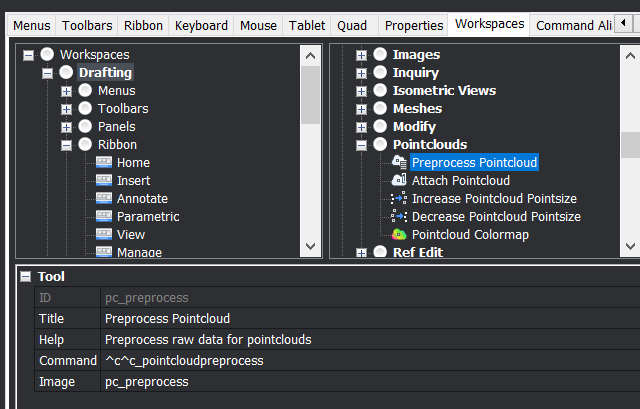Command aliases
Comments
-
Thank yes but there's very many more Poincloud commands that aren't in CUI>Customize. Is it just because they haven't got round to adding them yet? Or is it, as I saw it explained somewhere, that some (newer, non-Acad) 'commands' aren't proper commands, but something else - I'm wondering what that is.
0 -
Tom,
I don't have BIM so can't test it, but can you not get the name of the command from the command line and make an alias that way?
I tried a lisp routine that I loaded and ticked the Autoload in Appload and then created an Alias for that routine and it worked OK, and there is no reference to the lisp in a CUI or my on_doc_load.lsp so it is possible to create an Alias from a command that isn't in any CUI.
I'm sure you are aware of this technique but I just wanted to try it out of curiosity :-)
0 -
Yes, something usually appears on the command line any time I take any action, and whatever appears there should be a command name. That doesn't happen when I click on some of the toggle buttons at the bottom of the window, but I think there are in fact commands that do the same thing as any of those toggle buttons. Are the Pointcloud commands you're talking about executed in that way?
There's a list of Pointcloud commands here:
https://help.bricsys.com/hc/en-us/articles/360012945894-PointCloud0 -
Great - problem solved, entering 'new' command names myself in Customize>Aliases, as well as aliases.
So what is it I'm remembering, some Brics staffer expained that all 'old' Acad commands are genuine commands, but some newer ones look like commands but are something else - routines? - and the difference can be seen in modified ^c^c_ notation in Customize>Toolbars bottom panel. I thought he said that's the reason those aren't listed in Customize>Aliases and so can't be Aliased. Seems the latter is not right - so I'm puzzled (but it's no longer a problem - thanks).
0 -
A lisp function can also be called a routine, especially if it doesn't have the C: in its name that turns it into a custom command. Maybe that's what the staffer meant.
A non-command lisp function (enclosed in parentheses) can be entered on the command line or included in a menu item. So it's similar to a command in that sense. But you can't make an alias to it.
However, you CAN make an alias to a custom command that was created by a lisp function. It's still not quite the same as a built-in command -- it shouldn't be used in the lisp (command) function, for example. But it does accept an alias.
0 -
A macro that you can use in a menu item, like
^C^C_-layer;m;InteriorWalls;;_Mline, could also be called a routine. And you can't make an alias to a macro either. That's why I had to learn lisp -- because lisp can make custom commands, and I wanted to execute all my custom commands by one- or two-letter aliases from the keyboard. I rarely use pull-down menus, and I never use toolbars.0


